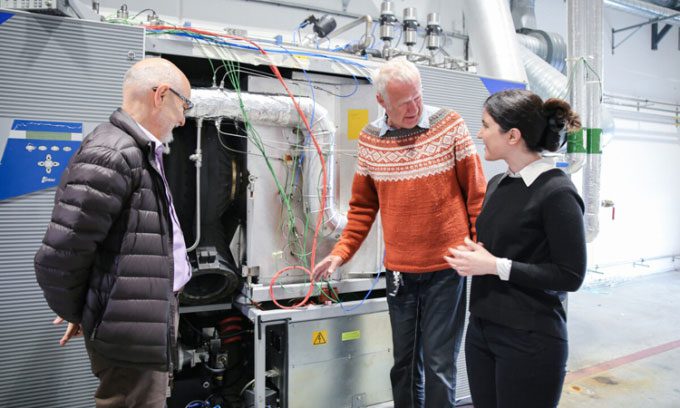A team of experts at the University of Stavanger has developed a 100% hydrogen-powered gas turbine, allowing for the utilization of existing infrastructure while producing no CO2.
Gas turbines are used in aircraft, trains, ships, generators, pumps, compressors, and many other applications. They can operate on various types of fuel, but approximately 90% currently run on natural gas—a fossil fuel that emits CO2 when burned. Additionally, when extracted from the ground, it contributes to a greenhouse effect that is 80 times worse than CO2 over a period of 20 years.

Professor Mohsen Assadi (left), engineer Bjarte Hetlelid (center), and Dr. Reyhaneh Banihabib (right) with the world’s first gas turbine running entirely on hydrogen. (Photo: UiS)
In the race towards achieving net-zero emissions by 2050, there is a need to change or eliminate gas turbines. Some companies, including General Electric (GE), are exploring the transition to burning green hydrogen as a clean fuel source. GE has over 100 turbines operating on at least 5% hydrogen by volume and is aiming for 100% hydrogen operation.
Researchers at the University of Stavanger, Norway, announced that they have created a 100% hydrogen gas turbine since mid-May this year, as reported by New Atlas on June 10.
The University of Stavanger operates a small gas power plant that generates both heat and electricity. The plant also provides hot water for heating laboratories in the surrounding area. Excess electricity is fed into the local power grid and thermal network of the electricity provider Lyse, ensuring efficient energy use.
“We have set a world record for burning hydrogen in a micro gas turbine. Previously, no one could produce at this level,” said Professor Mohsen Assadi, the research team leader. He, along with Dr. Reyhaneh Banihabib, engineer Magnus Wersland, and Bjarte Hetlelid from the NORCE research institute, conducted the plant trials. They demonstrated that hydrogen can be used in existing natural gas infrastructure.
“The efficiency of running a gas turbine on hydrogen will be slightly lower. However, the significant benefit is the utilization of existing infrastructure. Additionally, this method of energy production does not emit CO2,” Assadi stated.
The new research not only focuses on adjusting the combustion chamber for hydrogen but also on modifying the fuel system and old natural gas infrastructure to accommodate this very different gas. The research team is closely examining the plant’s limitations and seeking ways to increase capacity to generate as much clean energy as possible.
Such projects will provide effective conversion solutions, helping to maintain old turbine equipment while transitioning to emission-free fuels. However, for them to be economically viable, the cost of green hydrogen needs to decrease significantly, and carbon taxes should be applied to cheaper fossil fuel methods.




















































